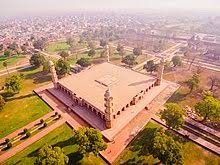History of Tomb of Jahangir
Jahangir's Tomb (constructed 1627-37)
The burial place of Jahangir is situated in Shahdara, a suburb of Lahore toward the northwest of the city. The region had been a most loved spot of Jahangir and his significant other Nur Jahan when they lived in Lahore, and the region was ordinarily utilized as a take-off point for movements to and from Kashmir and Lahore. At the point when Jahangir kicked the bucket in 1627 he might have at first been covered in Shahdara in one of its many nurseries. His child, Shah Jahan, requested that a sepulcher befitting an Emperor be worked as a long-lasting dedication.
Development of the tomb endured 10 years, from 1627 to 37, and was likely supported by the majestic depository (however there is some proof that Jahangir's better half, Nur Jahan, may have financed the development). It possesses a huge quadrangle estimating 600 gaz (around 500 meters) to a side and is partitioned into four chahar baghs (four-section gardens). A wellspring involves the focal point of each of the chahar baghs and the roads in the middle, making a ring of 8 wellsprings around the focal burial chamber. Water for the wellsprings was provided by wells outside of the nursery and raised into channels on of the dividers utilizing water wheels that are presently not surviving. From that point, the water moved through earthenware pipes and into the wellsprings, whereupon the water fell into shallow channels running all through the nursery.
The actual catacomb is square in arrangement and precisely 100 gaz to a side. Aside from the four corner minarets the format is completely even with a level rooftop covering the entire of the design. Almost certainly, this got from the model set by Jahangir's granddad, Babur, who favored entombment in a burial chamber open to the sky with regards to Sunni Islam precident. Both Jahangir and Shah Jahan would have been acquainted with Babur's burial place garden in Kabul in which Babur's desires were completed - a screen was raised around the grave site however the cenotaph was not roofed over. At Jahangir's burial place, a trade off of sorts was shown up at by raising a rooftop over the cenotaph yet not building any great embellishments like arches. This plan was clearly not exceptionally famous as it was repeated just a single time for the burial chamber of Nur Jahan, Jahangir's significant other, at her burial place garden likewise in Shahdara. Shah Jahan himself was covered in the Taj Mahal, a landmark prestigious for its utilization of vaults as structural components.
At the focal point of the sepulcher is an octagonal burial place chamber around 8 meters in breadth. It is associated with the outside of the burial place by four corridors confronting the four cardinal bearings. The cenotaph at the middle is cut from a solitary piece of white marble and improved with pietra dura decorates of the 99 properties of God. At its foot is an engraving in Persian recording that "This is the enlightened grave of His Majesty, the Asylum of Pardon, Nooruddin Muhammad Jahangir Padshah 1037 AH".
The foundation of Jahangir's burial place at Shahdara significantly influenced the personality of the suburb. Though already the region has been utilized as a position of unwinding, during Shah Jahan's time the rural area was changed into a landmark to the Mughal's supreme standard. This was just reinforced by the development of a jilau khana (forecourt) toward the west of the burial place and the ensuing development of a burial place to Jahangir's central pastor Asaf Khan toward the west. The gathering arrived at its pinnacle when Nur Jahan herself was let go in a burial place somewhat toward the southwest of different burial places.
Today, the burial place of Jahangir holds exceptional importance for Pakistanis as it is the solitary Mughal burial place situated in present-day Pakistan. Its picture shows up on the 1,000 rupee banknote and it stays one of Lahore's most well known attractions.
To Read More Blogs Check This :



No comments:
Post a Comment